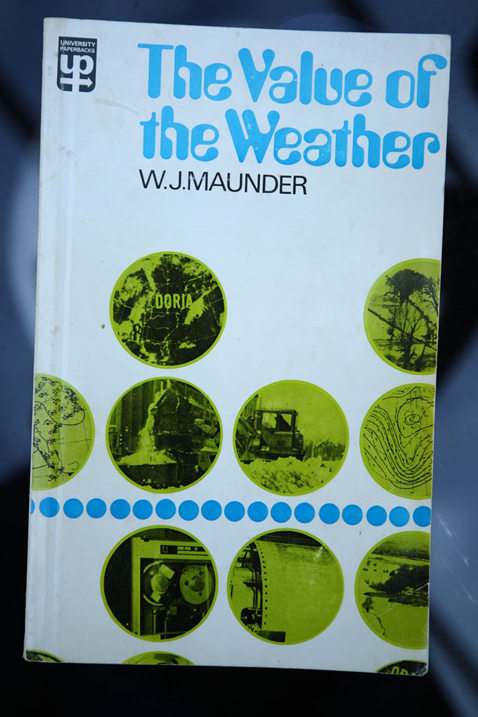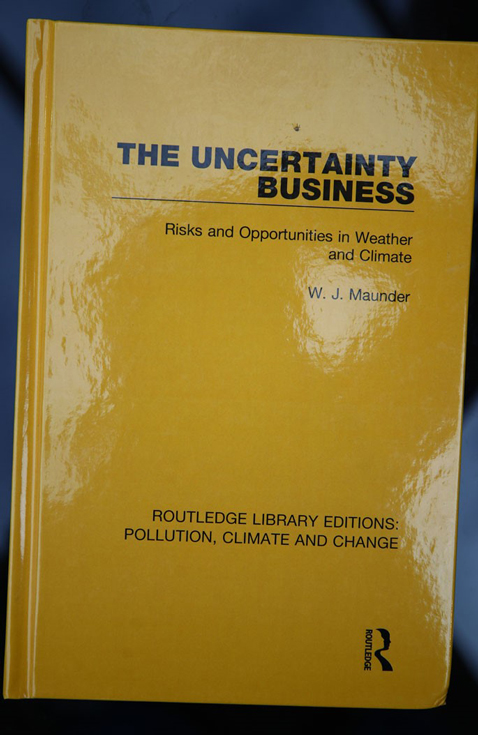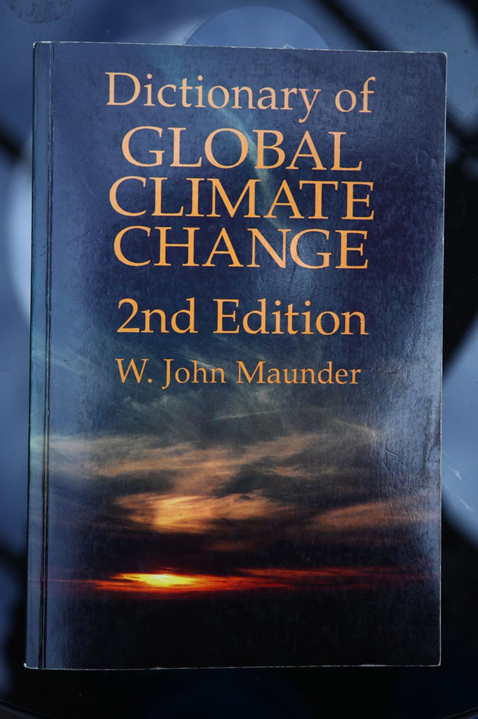 |
Weather Eye with |
Over 55 years ago in April 1968 when I was an Assistant Professor in the Department of Geography in the University of Victoria in Canada,
I remember very well when on a Wednesday morning the representative from the British publishers Methuen and Co came to see me in my office, and showed me the new books which were available for the courses I was involved in.
I said to him 'when are you going to produce a ‘decent' text book”.
He said what to you mean. I said a climate book which was about the non-scientific aspects of weather and climate, notably the economic, social, legal, and political aspects of the subject, rather than the traditional weather and climate book which dealt with the atmospheric circulation, climate applications etc.
His reply was very much to the point and he simply said "Why don't you write it" . He was very helpful and suggested I write 10 pages on 'the benefits of tropical cyclones” from the middle of the proposed book, which I named The Value of the Weather.
As I had a captive audience of senior students, I then wrote the 10 pages and gave it to my students, explaining what I was doing, and asked them to use their red pens and to make suggestions for improvements!.
A few weeks later I sent the manuscript to Methuen's in Toronto and rather surprisingly received a call from them the next week offering me a contract.
However, they wanted to send my manuscript to the Methuen's head office in London., and after a few weeks I received a second call saying that Methuen in London would also like to publish the book.
A week later I received the Royalty Agreement stating what the publisher required me to do, and what the publisher would do.
The Royalty Agreement among other things stated what payments (royalties) I would receive and what happened if the book was translated into other languages, and made into a film. Regrettably, the movie never came, but the book was published into Spanish.
Surprisingly at that time (1968) I had difficulty in finding a person at the university who had actually written a book, but several people were very helpful in looking at the fine print of the contract.
Because the book was published in both London and Toronto, I received royalties of 10 per cent of the published price of the book for sales in the US and Canada and the UK, and 12.5 per cent of the 'price obtained” from all other areas.
The effect of this meant that the 10,000 copies sold provided sufficient money for me to purchase a car.
More importantly it also opened up a weather/climate world in a much bigger way than I thought possible.

This was very much pre-internet days, and well before the costs and benefits of the impacts of weather became an issue, and what turned out to be the first of my five books "The Value of the Weather" which included sections on "consumers reaction to forecast presentation" and "the law and weather modification".
Then, before the rest of the world had worked out how to use weather and climate information and to manage the risks and opportunities of weather and climate variability and extremes, I wrote my second book (in 1986) and endeavoured to include sections on "The Ministry of Atmospheric Resources" and "the effect of weather on road construction" which captured the essence of the problem with the book ‘The Uncertainty Business.. Risks and opportunities in weather and climate.'

This was followed in 1989 by my third book "The Human Impact of Climate Uncertainty" which included sections on "Television weathercasting" and "Weather and wool production forecasting". Like my first book, my second and third books were published by Methuen and Co in London.
Much later in 2020 the three books were reprinted by Routledge, part of the Taylor and Francis Group in London and New York'.


Then before the First Report of the Intergovernmental Panel on Climate Change (IPCC) and the 1990 Second World Climate Conference had set in train the negotiation of the United Nations Framework Convention on Climate Change (UNFCCC), I produced in 1992, while working for for the Stockholm Environment Institute, a climate lexicon that became, for many years, the definitive international "‘Dictionary of Global Climate Change". This book was published by UCL in London.
The dictionary covered the full range of weather and climate terms from "abiotic" and "ablation" to "zonal index" to "zooplankton".

The idea for my fifth book came about when I was visiting my family in Adelaide in January 2020 during a heat wave.
One day when the forecast was for 45°C my daughter Denise suggested I should stay inside, shelter from the heat and write another book. I asked what did she have in mind and she simply said 'Climate the Truth”.
My son Philip, who has lived in Adelaide for about 35 years, thought it was a good idea but after a few days thought I settled on a more appropriate title "Fifteen shades of climate...the fall of the weather dice and the butterfly effect”.
The fifteen simply relates to the number of chapters in the book but it could more realistically relate to the fifteen or more facets of my eighty years in the 'weather business”.
The book was published in November 2020 by Amazon.
These years cover my schooling and work in New Zealand's Golden Bay and Nelson College, the University of Otago, the New Zealand Meteorological Service, the University of Victoria in Canada, the University of Missouri, the World Meteorological Organization, the University of Delaware, the 1985 WMO/ICSU/UNEP Villach Conference, the 1979 WMO First World Climate Conference, the 1990 Second World Climate Conference, the Stockholm Environment Institute, the University College Dublin, the weather business in New Zealand, the writing of five books, many scientific papers and a host of media releases.
*************************************
My thanks go to all my friends and colleagues all over the climate world who have kept me on the right path.


******************************
In mid-2023 it was suggested that I should change the name of the fifth book to"Climate Change: A Realistic Perspective" to better reflect its contents.
Note: I was born in Nelson (New Zealand) and lived inTakaka in 1938-45 when I watched the Takaka River flood, and as a 7 year old I asked two questions ..Why did it rain, and What were the consequences of the rain. I still have questions.
The new book is identical to the old book, with the exception that a new Author's Foreword has been included.

*******************************************************
In 2023 it was suggested that the title of my fifth book should be changed to better reflect its contents
********.
Author's Foreword to Second Edition.
Now that I am approaching my 92nd year, it seems appropriate that I should quote the words of Walter Cronkite of CBS fame, whose absolute commitment and reputation for objectivity always signed off his 6pm news bulletin with ..." And that's the way it is".
With so much information and misinformation about the climate story, perhaps the words of Cronkite should be a reminder to us all, including our decision makers and the media, that the sun, the volcanoes, and the oceans dominate the climate system.
Of course, now that we are through the 20th and into the 21st century, one must acknowledge the important human (including domestic animals) influence on the climate system. However one must also acknowledge that prior to about 1800, the climate variations which occurred (and there were many of them), were not - with very few exceptions - influenced by the activities of humans.
There is a great amount of evidence about detecting changes in the climate, and many reasons/causes of why the climate changes.
Among the evidence for detecting climate change are instrumental records which include satellite observations, extreme weather events, historical records (eg crop records, church attendance), sea level changes, lake varves, glacial advances and retreats, ice cores, rocks, and tree rings.
Among the causes of why the climate changes is methane, carbon dioxide, solar activity - including sunspots, the Earth's orbit and rotation, the Earth's reflectivity, volcanic activity, ocean circulation, generating power, using transportation, producing food, heating and cooling of buildings, planetary cycles (e.g. Milankovitch cycles), and the ever increasing world's population.
In considering both the evidence for climate change and the causes of climate change, there are many questions as to the credibility of the "evidence". Some of this "credibility" relates to the reliability of the records, and this includes the "authority" making the observations. There have been many cases where the evidence for and the causes of climate change have been challenged.
I have spent the last 70 years studying and writing, as objectively as I can, about the evidence, causes and impacts of climate and climate change. I have written this book to summarise what I have learned. And, like Walter Cronkite, I would like to sign off with the assurance that, to the best of my knowledge, “And that's the way it is”.
**********************
FOREWORD ( to the First Edition) by John Zillman AO FAA FTSE Former Director (1978-2003) of the Australian Bureau of Meteorology, and Former President (1995-2003) of the World Meteorological Organization
There are probably few people in the world who have originated and accumulated as much detailed knowledge of as many different shades of climate as John Maunder. He is a font of wisdom on climate matters and I believe he has served the world extremely well over the past 50 years through the way he has shared that knowledge and wisdom with the global community. ......
******************************
NOTE I was born in Nelson (New Zealand) and lived inTakaka in 1938-45 when I watched the Takaka River flood, and as a 7 year old I asked two questions ..Why did it rain, and What were the consequences of the rain. I still have questions, some of which are answered in my book .
The new book is identical to the old book, with the exception that a new Author's Foreword has been included.
The new book has just been published on Amazon. To purchase a copy of the book please Google " Climate Change: A Realistic Perspective"
Now that I am approaching my 92nd year, it seems appropriate that I should quote the words of Walter Cronkite of CBS fame, whose absolute commitment and reputation for objectivity always signed off his 6pm news bulletin with ..." And that's the way it is".
With so much information and misinformation about the climate story, perhaps the words of Cronkite should be a reminder to us all, including our decision makers and the media, that the sun, the volcanoes, and the oceans dominate the climate system.
Of course, now that we are through the 20th and into the 21st century, one must acknowledge the important human (including domestic animals) influence on the climate system. However one must also acknowledge that prior to about 1800, the climate variations which occurred (and there were many of them), were not - with very few exceptions - influenced by the activities of humans.
There is a great amount of evidence about detecting changes in the climate, and many reasons/causes of why the climate changes.
Among the evidence for detecting climate change are instrumental records which include satellite observations, extreme weather events, historical records (eg crop records, church attendance), sea level changes, lake varves, glacial advances and retreats, ice cores, rocks, and tree rings. Among the causes of why the climate changes is methane, carbon dioxide, solar activity - including sunspots, the Earth's orbit and rotation, the Earth's reflectivity, volcanic activity, ocean circulation, generating power, using transportation, producing food, heating and cooling of buildings, planetary cycles (e.g. Milankovitch cycles), and the ever increasing world's population.
In considering both the evidence for climate change and the causes of climate change, there are many questions as to the credibility of the "evidence". Some of this "credibility" relates to the reliability of the records, and this includes the "authority" making the observations. There have been many cases where the evidence for and the causes of climate change have been challenged.
I have spent the last 70 years studying and writing, as objectively as I can, about the evidence, causes and impacts of climate and climate change. I have written this book to summarise what I have learned. And, like Walter Cronkite, I would like to sign off with the assurance that, to the best of my knowledge, “And that's the way it is”.
**********************
FOREWORD ( to the First Edition) by John Zillman AO FAA FTSE Former Director (1978-2003) of the Australian Bureau of Meteorology, and Former President (1995-2003) of the World Meteorological Organization
There are probably few people in the world who have originated and accumulated as much detailed knowledge of as many different shades of climate as John Maunder. He is a font of wisdom on climate matters and I believe he has served the world extremely well over the past 50 years through the way he has shared that knowledge and wisdom with the global community.
